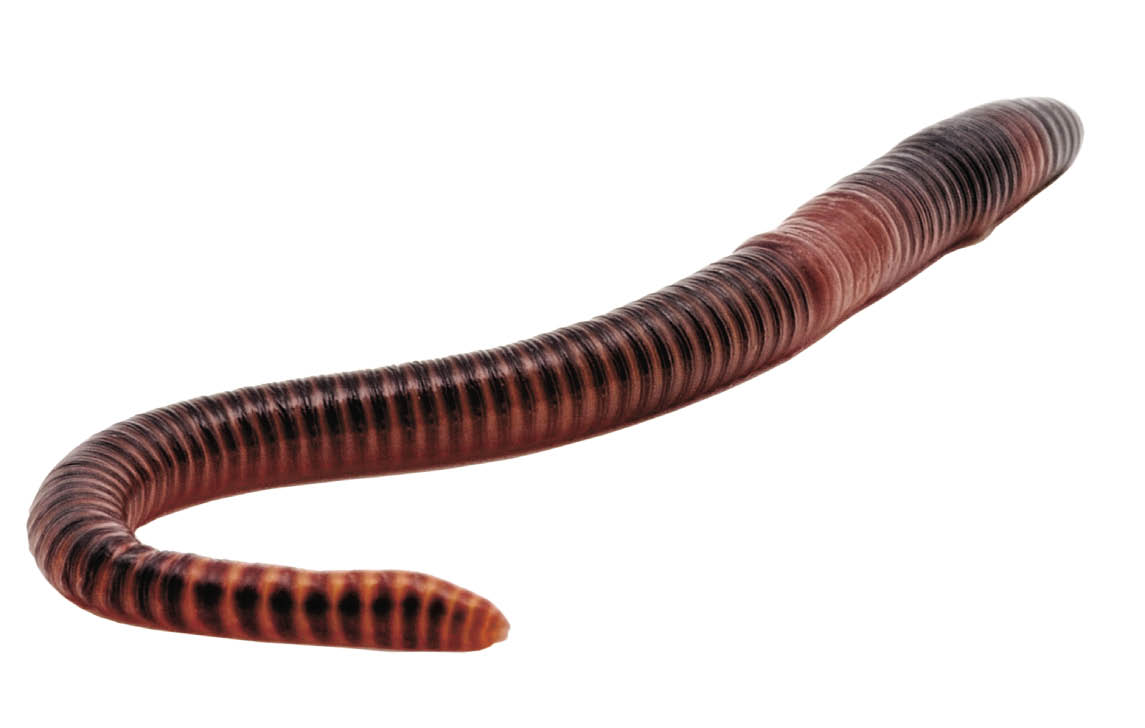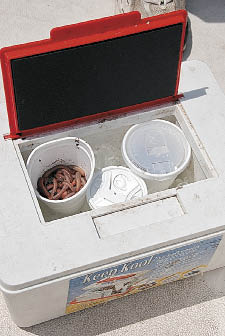 During what can be the toughest time of the year to tempt a fish into biting whatever you can think of to hang from a hook, many anglers go back to basics and start using live bait. Such was the case on a recent late-summer day when I went fishing with the owner of a local marina-who also happens to be a respected walleye angler.
During what can be the toughest time of the year to tempt a fish into biting whatever you can think of to hang from a hook, many anglers go back to basics and start using live bait. Such was the case on a recent late-summer day when I went fishing with the owner of a local marina-who also happens to be a respected walleye angler.
Fully expecting to be trolling hardware as usual, in the form of colorful spoons and crankbaits carefully designed to "match the hatch" and mimic the lake's primary food source for gamefish-emerald shiners-a surprise was in store. Stepping aboard, I was surprised to see a rather sophisticated worm "crib" discreetly placed in a shady corner of the cockpit.
_fmt.jpeg)
Sure enough, once Captain Bob slowed the boat over an offshore sandbar and turned the craft into a traditional downwind trolling position, he broke out the crawler harnesses and baited all six rods with some of the plumpest, liveliest worms I have ever skewered with the point of a fishing hook. The crawlers were plucked from thick foam cups suspended in a frigid mix of ice and water inside a larger container, and were actually cold to the touch.
But they proved to be hot baits to the fish on that day, allowing us to boat a half dozen walleyes up to eight pounds on a short trip in the heat of the afternoon. Back at the dock, we found ourselves to be the lone success story out of a dozen boats that had been out fishing-some many hours more that we had wet our lines. It turns out we were the lone boat using live bait that day as well.
That occasion represents but one of countless fishing trips for me over the years that have been saved by worms. Just this spring on an outing for crappies, we were loaded up with the traditional fathead minnows for bait. The spawning fish had been swarming the shallows around the docks where our boat is secured each season, and we had been reaping the succulent "slab" benefits for the past week. Using nothing more than a minnow lip-hooked and suspended a foot or so beneath a bobber, the crappies cooperated in kind-and quantity.
_opt.jpeg) Three days, one warm front and five degrees of surface temperature later and the crappies were nowhere to be found-at least within casting distance of our docked boat. And because I had a neighbor kid along and had not asked his parents' permission to take him and my own son out on the boat that day, we were limited to fishing from the docks and shore, where, as fate would have it, with the crappies headed for deep water, nothing was interested in eating a fathead minnow.
Three days, one warm front and five degrees of surface temperature later and the crappies were nowhere to be found-at least within casting distance of our docked boat. And because I had a neighbor kid along and had not asked his parents' permission to take him and my own son out on the boat that day, we were limited to fishing from the docks and shore, where, as fate would have it, with the crappies headed for deep water, nothing was interested in eating a fathead minnow.
Kicking some dead leaves aside with the toe of my shoe as I paced the shore, I exposed a small worm-which my son pounced upon and threaded onto his hook. He swung it out keeping it close to the shore and before you could say, "Dad, can you kick me up another bait?" he was fast to a fat bluegill. The boys received a clinic in finding their own worms that day, leaving nary a rock or log unturned or leaf pile un-kicked along a 20-yard stretch of bank that surrendered some 20 sunfish in the next two hours.
When I am faced with "having" to catch most any freshwater gamefish, my thoughts turn to worms immediately. My first trout was taken with a worm dug by hand from a manure pile on the bike ride to a small Vermont stream from where I lived for a time after high school. That summer I perfected a technique I still use on pressured trout to this day, dead-drifting a small worm on a light wire hook attached to four-pound test line into a stream's deepest holes, allowing the current to direct the bait into places it would drift naturally. Yes, the fooled fish often swallow the bait, but I'm "meat" fishing when using this technique and my quarry is destined to die for the frying pan anyway. A quick thump to the head dispatches the trout before it suffers from the removal of a deeply imbedded hook, and the dead-drift tactic has provided many a meal when no other method worked.
I nearly always have a container of worms aboard when I am boating with the intent to fish. If I can be successful using artificial lures, I may never break out the crawlers, and some years have kept the same cottage cheese container full of worms for the greater part of a fishing season. But eventually, the fish get finicky and that spells doom for my resident `crawlers. And year-in and year-out, that time is often just about now.
 Proper Worm Care
Proper Worm Care
Heat is the most debilitating factor facing worms and nightcrawlers, which need little more than dampness and darkness to thrive. Worm bedding comes in the form of plain old garden dirt, peat moss, sphagnum moss, shredded newspaper and commercial products. Many boaters prefer sphagnum moss because it's the least messy; charter fishermen typically "wash" worms prior to each trip, rinsing them in lake water to get the dirt off and then keep the crawlers in ice water within easy reach of the anglers. Some even squirt a shot of fish attractant into the crawler water to give the baits more appeal.

